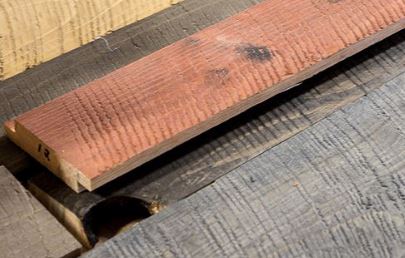Shiplap is a classic design feature that has experienced a resurgence in popularity in recent times. Its distinctive horizontal planks have the power to instantly elevate the aesthetics of a room, giving it a cozy and rustic feel. However, the key to a durable and visually appealing shiplap installation lies in the choice of nails.
In this article, we’ll explore whether 18 gauge nails are suitable for shiplap, and we’ll delve into various aspects of shiplap installation, providing you with all the information you need to embark on this DIY journey confidently.
Understanding Shiplap

Definition and History of Shiplap
- Defining Shiplap: Shiplap is a type of wooden board used in construction and interior design, known for its distinctive horizontal groove and tongue profile.
- Historical Roots: Shiplap’s name is derived from its maritime origins, where it was used to construct ship hulls. Trace the historical evolution of shiplap from shipbuilding to interior design.
Shiplap as a Versatile Interior Design Trend
- The Modern Resurgence: Examine the resurgence of shiplap in the field of interior design over the past few years.
- Aesthetic Appeal: Explore the visual appeal of shiplap, including its ability to add texture, depth, and a rustic charm to interiors.
- Versatility: Explain how shiplap can complement various design styles, from farmhouse to coastal and contemporary.
Different Types of Shiplap and Their Uses
- Traditional Shiplap: Describe the classic, solid wood shiplap boards and their applications.
- MDF Shiplap: Discuss medium-density fiberboard (MDF) shiplap as a cost-effective alternative and its suitability for certain projects.
- Reclaimed Wood Shiplap: Highlight the unique character of reclaimed wood shiplap and its eco-friendly appeal.
- Vinyl Shiplap: Mention low-maintenance vinyl shiplap and its use in wet areas like bathrooms.
- Painted vs. Natural Finish: Compare the look and feel of painted shiplap to natural wood finishes, guiding readers on choosing the right option.
By elaborating on these aspects, readers will gain a comprehensive understanding of shiplap, its historical context, its role in contemporary interior design, and the various types available for their projects.
Can I Use 18 Gauge Nails for Shiplap?
Shiplap installation requires precision and the right materials. One crucial aspect is choosing the correct nails. So, can you use 18 gauge nails for shiplap? The answer is yes, but with some considerations.
Advantages of 18 Gauge Nails
Strength and Durability of 18 Gauge Nails
- Material Composition: Explain that 18 gauge nails are typically made of high-quality steel, making them sturdy and resilient.
- Weight-Bearing Capacity: Highlight the strength of 18 gauge nails, discussing their ability to hold substantial weight.
- Resistance to Corrosion: Mention that many 18 gauge nails are coated to resist rust and corrosion, ensuring long-lasting performance.
How 18 Gauge Nails Provide a Secure Hold
- Precision: Describe how the slim profile of 18 gauge nails allows for precise placement in shiplap boards without causing excessive splitting.
- Even Distribution: Explain how the number of nails used can evenly distribute the load, preventing warping or bowing of shiplap boards.
- Reduced Risk of Popping: Discuss how 18 gauge nails, when driven correctly, reduce the likelihood of nails “popping” through the surface of the shiplap over time.
Their Compatibility with Shiplap Materials
- Versatility: Emphasize that 18 gauge nails are suitable for a wide range of shiplap materials, including wood, MDF, and reclaimed wood.
- Minimized Damage: Explain that the size and gauge of these nails help minimize the risk of damage to shiplap boards during installation.
- Smooth Finish: Mention that 18 gauge nails can provide a clean, smooth finish to shiplap walls, enhancing the overall aesthetic.
Factors to Consider
Before you rush to use 18 gauge nails for your shiplap project, consider these factors:
- Wood Type: The type of wood you’re using for your shiplap matters. Softer woods like pine may work well with 18 gauge nails, while hardwoods may require thicker nails for a secure hold.
- Wall Structure: Assess the wall structure. If you’re attaching shiplap to drywall, 18 gauge nails should suffice. However, if you’re nailing into studs, you may opt for thicker nails for added stability.
- Nail Length: The length of the nail matters. Make sure the nails are long enough to penetrate the shiplap and anchor securely into the wall or studs.
- Spacing: Proper nail spacing is crucial. Follow manufacturer recommendations for the correct distance between nails to ensure the shiplap remains secure.
- Project Type: Consider the project type. If you’re installing shiplap on a ceiling or a high-traffic area, you may want to opt for thicker nails to enhance durability.
- Aesthetics: Think about the final look you want to achieve. Thinner nails may leave smaller holes that are easier to fill and conceal, contributing to a cleaner finish.
Shiplap Installation Steps
Now that you know 18 gauge nails can be used for shiplap, let’s go through the general steps of shiplap installation to ensure a successful project:
Step 1: Gather Your Materials
Before you begin, gather all the necessary materials, including shiplap boards, 18 gauge nails, a level, a saw, a nail gun (if preferred), and safety gear.
Step 2: Measure and Cut
Measure the wall or ceiling where you’ll install the shiplap. Mark the measurement on the shiplap boards and use a saw to make precise cuts.
Step 3: Locate Studs
Use a stud finder to locate and mark the position of wall studs. This step is crucial for secure attachment.
Step 4: Start Installation
Begin at one corner and attach the first shiplap board using your 18 gauge nails. Ensure it’s level and securely fastened.
Step 5: Continue Installation
Continue attaching shiplap boards, ensuring they overlap properly for that classic shiplap look. Use a level to maintain straight lines.
Step 6: Finishing Touches
Complete the installation by trimming boards as needed to fit corners and edges. Fill nail holes with wood filler, sand, and paint or stain as desired.
18 Gauge Nails vs. Other Gauges
Compare 18 Gauge Nails with Other Common Gauges (16, 20)
18 Gauge Nails
- Size: Explain that 18 gauge nails have a medium thickness, making them versatile.
- Common Use: Describe their frequent use in various woodworking and finishing applications.
- Strength: Highlight their moderate strength, suitable for most interior projects.
16 Gauge Nails
- Size: Point out that 16 gauge nails are thicker and larger than 18 gauge.
- Common Use: Explain that they are commonly used for framing and heavier carpentry work.
- Strength: Emphasize their high load-bearing capacity.
20 Gauge Nails
- Size: Mention that 20 gauge nails are thinner and finer than 18 gauge.
- Common Use: Indicate their use for delicate trim work and lighter applications.
- Strength: Note their limited load-bearing capacity due to their smaller size.
Advantages and Disadvantages of Each Gauge

18 Gauge Nails
Advantages:
- Versatility: Suitable for a wide range of projects.
- Balanced Strength: Offers a strong hold without excessive thickness.
- Reduced Risk of Splitting: Less likely to split wood compared to thicker gauges.
Disadvantages:
- Not Ideal for Heavy Loads: May not be the best choice for extremely heavy applications.
16 Gauge Nails
Advantages:
- High Strength: Can handle heavy loads and structural tasks.
- Durability: Well-suited for demanding construction projects.
Disadvantages:
- Risk of Splitting: Thicker gauge nails can split delicate materials.
- Less Versatile: Not as versatile as 18 gauge for finer work.
20 Gauge Nails
Advantages:
- Precision: Ideal for delicate trim and finish work.
- Reduced Surface Damage: Less likely to leave noticeable holes.
Disadvantages:
- Limited Strength: Not suitable for load-bearing or structural applications.
- Risk of Pulling Out: May not hold well in heavier materials.
Why 18 Gauge Nails Strike a Balance
- Versatility: Explain that 18 gauge nails strike a balance between the thicker 16 gauge and finer 20 gauge nails, making them suitable for a wide array of projects.
- Strength-Size Ratio: Mention that their moderate thickness provides ample strength while minimizing the risk of splitting delicate materials.
- Common Usage: Emphasize that 18 gauge nails are widely used in carpentry and woodworking, making them a go-to choice for many DIY enthusiasts and professionals.
FAQ About Can I Use 18 Gauge Nails for Shiplap
Can I use 16 gauge nails for shiplap instead of 18 gauge?
While 16 gauge nails are thicker and provide added strength, 18 gauge nails can still be suitable for shiplap, depending on the factors mentioned earlier.
Do I need to glue shiplap in addition to nailing it?
Gluing shiplap is optional but can provide extra stability. If you choose to use adhesive, apply it to the back of each board before nailing.
How do I prevent shiplap from warping over time?
To prevent warping, ensure proper spacing between boards, use the right nails, and seal or paint all sides of the shiplap to minimize moisture absorption.
Can I install shiplap on a textured wall?
Yes, you can install shiplap on a textured wall, but it may require additional preparation, such as adding furring strips to create a flat surface.
Should I acclimate shiplap to the room’s humidity before installation?
Yes, it’s a good practice to let shiplap acclimate to the room’s humidity for a few days to minimize the risk of expansion or contraction after installation.
Can shiplap be installed in bathrooms or kitchens?
Shiplap can be installed in these areas, but it’s essential to use appropriate moisture-resistant materials and seal the shiplap properly to protect against moisture damage.
In The End
Using 18 gauge nails for shiplap can be a viable option, provided you consider the type of wood, wall structure, and project requirements. Remember that the key to a successful shiplap installation lies in proper preparation and attention to detail. By following the steps outlined in this guide and considering the FAQs, you’ll be well-equipped to embark on your shiplap project with confidence.
Related Topics:
- Why Do Nails Rust
- Is a Nail a Conductor or Insulator
- How to Hammer Nail Into Concrete Wall Without Drill
- How to Unjam a Nail Gun
- What Are Construction Nails Made Of
- Why Do Builders Use Nails Instead of Screws

